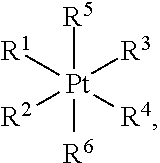Dual targeting anticancer agents
- Summary
- Abstract
- Description
- Claims
- Application Information
AI Technical Summary
Benefits of technology
Problems solved by technology
Method used
Image
Examples
example 1
[0154]Platinum-based anticancer agents induce apoptosis by damaging nuclear DNA in cancer cells. Following the success of cisplatin over the past few decades, platinum(II) analogues, including carboplatin, oxaliplatin, nedalplatin, and lobaplatin, have been introduced into the clinic to treat various cancers. Despite their efficacy, the inherent side effects and limitations of platinum(II) compounds remain problematic. Platinum(IV) prodrugs offer a viable alternative to platinum(II) therapy. Surrounded by six ligands in an octahedral coordination environment, the platinum(IV) metal center is more inert toward substitution reactions than platinum(II). Upon reduction, two axial ligands are released and the corresponding divalent species is generated. Chemical modification of the axial ligands can significantly influence the efficacy and pharmacokinetics of platinum(IV) agents. Single agents with dual-targeting capabilities provide a powerful approach to attack cancer cells.
[0155]In th...
example 2
[0158]This example describes the anti-proliferative and cellular uptake properties of vitamin E analogs conjugated to Pt(IV) complexes.
[0159]The anti-proliferative properties of Pt(IV)(α-TOS)(OEt), Pt(IV)(α-TOS)2, α-TOS, Pt(IV)(OAc)2, cisplatin, mixtures of α-TOS and cisplatin were evaluated by the MTT assay and the results are summarized in Table 1. Pt(IV)(OAc)2 is known to be non-therapeutically active and was used as a control platinum (IV) compound. Pt(IV)(α-TOS)2 displayed moderate to low toxicity against all cell lines. Conversely, Pt(IV)(α-TOS)(OEt) exhibited impressive potency, 7-220 times greater than that of cisplatin or combinations of cisplatin and α-TOS, across several tumour cell lines. Encouragingly Pt(IV)(α-TOS)(OEt) exhibited lower toxicity against healthy cells. Notably, a 265-fold reduction in toxicity was observed for non-tumorigenic lung fibroblast cells (MRC-5) compared to ovarian carcinoma cells (A2780). The difference in toxicities of Pt(IV)(α-TOS)2 and Pt(IV...
example 3
[0162]This example describes the mechanism of action of the vitamin E analogs conjugated to Pt(IV) complexes.
[0163]α-TOS is known to disrupt Bcl-xL-Bax interactions, activate Bax, and thus mediate mitochondrial centered apoptotic cell death. Co-immunoprecipitation studies were carried out to determine whether the Pt(IV)-α-TOS conjugates could behave in a similar manner. To probe the Bcl-xL-Bax interaction dynamics, A549 cells were incubated with α-TOS, cisplatin, Pt(IV)(α-TOS)2, Pt(IV)(α-TOS)(OEt), and Pt(IV)(OAc)2 at the respective IC50 values for 48 h, the cell lysates were then subjected to immunoprecipitation with Bcl-xL antibody, and, finally, the immunoprecipitates were probed for Bax content using immunoblotting. The results are shown in FIG. 2. FIG. 3 shows immunoblotting analysis of Bcl-xL expression upon cisplatin, mixtures of α-TOS and cisplatin, Pt(IV)(α-TOS)2, Pt(IV)(α-TOS)(OEt), and Pt(IV)(OAc)2 treatment. As expected, upon α-TOS treatment, the level of Bax associated ...
PUM
| Property | Measurement | Unit |
|---|---|---|
| Electrical resistance | aaaaa | aaaaa |
Abstract
Description
Claims
Application Information
 Login to View More
Login to View More - R&D
- Intellectual Property
- Life Sciences
- Materials
- Tech Scout
- Unparalleled Data Quality
- Higher Quality Content
- 60% Fewer Hallucinations
Browse by: Latest US Patents, China's latest patents, Technical Efficacy Thesaurus, Application Domain, Technology Topic, Popular Technical Reports.
© 2025 PatSnap. All rights reserved.Legal|Privacy policy|Modern Slavery Act Transparency Statement|Sitemap|About US| Contact US: help@patsnap.com



